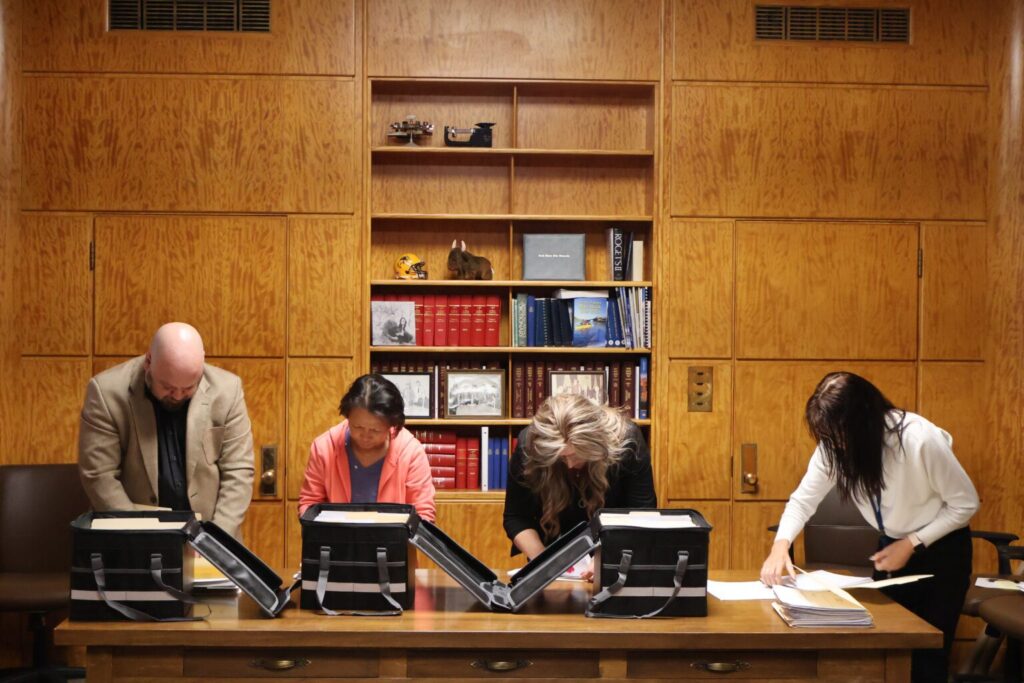Staff count packets of signed petitions in the Secretary of State’s Office on Feb. 9, 2024, in Bismarck. The petitions call for placing a measure on the election ballot to establish an age limit for North Dakota congressional delegates. (Mary Steurer | North Dakota Monitor)
A newly passed North Dakota law could give the U.S. Supreme Court an opportunity to revisit restrictions on who can run for federal office, a legal expert says.
North Dakotans voted Tuesday to make it illegal for anyone to be elected or appointed to represent the state in Congress if they’d turn 81 before the end of their term.
The measure passed with nearly 61% approval from voters, according to unofficial results from the North Dakota Secretary of State’s Office.
Despite the amendment’s clear popularity with North Dakota voters, officials are expecting it to trigger a legal battle. A committee of state legislators estimated in April that the measure would take roughly $1 million to defend in court if passed.
State leaders have said the law may conflict with a U.S. Supreme Court ruling from 1995 that found states cannot restrict who can run for federal office.
Justices cited this same case — U.S. Term Limits vs. Thornton — in March when they voted unanimously that states could not disqualify former President Donald Trump from appearing on election ballots.
If there is a lawsuit against North Dakota’s age limits measure, and it does make it to the Supreme Court, there’s no guarantee justices will continue to affirm that precedent. The high court could always decide to rethink its 1995 ruling, said Michael Thorning, director of the Bipartisan Policy Center’s Structural Democracy Project.
“The current court has demonstrated a willingness, I think, to review current precedent and overturn it,” Thorning said.
He pointed out only one current justice was on the bench back when the 1995 case was decided, Clarence Thomas.
Notably, Thomas was against the ruling. He authored a dissenting opinion joined by fellow conservatives Chief Justice William Rehnquist and Justice Antonin Scalia, as well as Justice Sandra Day O’Connor, a moderate.
“Nothing in the Constitution deprives the people of each State of the power to prescribe eligibility requirements for the candidates who seek to represent them in Congress,” Thomas wrote in the opinion.
Overall, it’s statistically unlikely that the Supreme Court will hear the case. The court takes up only a tiny fraction of cases they’re petitioned to review.
Jared Hendrix, who led the charge to get the measure on the ballot, said he would support the court overturning the 1995 ruling.
“I do believe the (Thornton) case was very flawed in its reasoning,” Hendrix said.
Hendrix has said the measure is a way for voters to ensure that congressional delegates are mentally and physically fit for the job, and that they are in touch with the needs of their constituents.
The measure is especially timely considering some of the nation’s most visible politicians are also some of its most aged, Hendrix has said.
President Joe Biden, 81, and former President Donald Trump, 78, are the oldest and third-oldest American presidents ever, respectively. The current average age of Congress is also one of the oldest in the nation’s history, according to the Pew Research Center.
Hendrix has disputed lawmakers’ estimate that the measure could cost the state $1 million in legal fees, calling the figure “inflated.”
In order for the Supreme Court to weigh in on the law, someone would first have to sue the state over the measure.
Not just anyone would have standing to bring such a case. To have the right to fight a law in court, plaintiffs generally have to prove the law harms them in some way.
One example might be a candidate who is barred from seeking office under the policy, Thorning said.
None of North Dakota’s current D.C. delegation — or anyone in the state currently seeking election to Congress — is near age 81. The state’s oldest member of Congress, U.S. Sen. John Hoeven, is 67.
The 1995 Supreme Court case, which struck down an Arkansas congressional term limits law, stemmed from lawsuits originally filed by a private citizen, the League of Women Voters and a U.S. representative.
What would happen if the Supreme Court overturned the 1995 term-limits case? States would have much greater authority to gatekeep who could run for federal office, Thorning said. This wouldn’t be limited to age.
“Would it be allowable, then, for the state, for instance, to say that members of Congress can only be elected from certain counties within their state, or certain cities, or only ones that have met certain educational qualifications?” he asked.
States would still have to comply with the 14th Amendment, he noted, which would prevent states from barring someone from running for Congress based on race or gender, for instance.
What if the Supreme Court declines to take the case, or upholds its 1995 ruling?
Congress could vote to amend the U.S. Constitution to set a nationwide age limit on elected officials.
Hypothetically, state legislatures could also bypass Congress by passing resolutions calling for the amendment to be adopted through a constitutional convention. According to U.S. Term Limits’ website, some states have already passed such resolutions. They would need a total of 34 in order to trigger a convention. There’s only ever been one U.S. Constitutional Convention, which took place in 1787.
This story was originally published by the North Dakota Monitor, which is part of States Newsroom, a nonprofit news network, including the Daily Montanan, supported by grants and a coalition of donors as a 501c(3) public charity.
The post North Dakota congressional age limits law could lead to new legal review appeared first on Daily Montanan.

